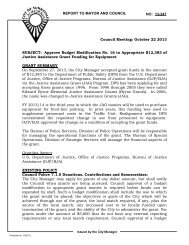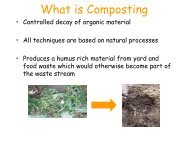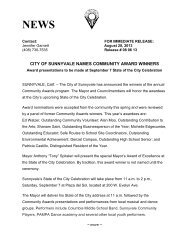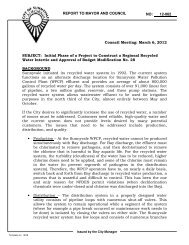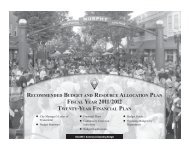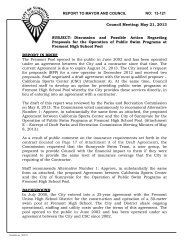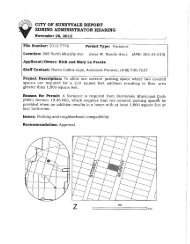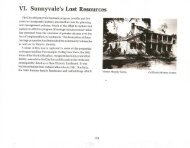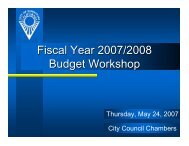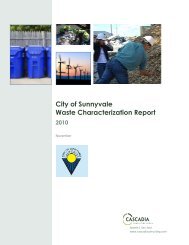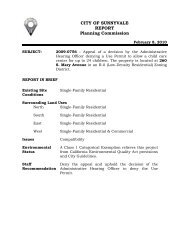Agenda Item # 3 Draft for Planning Commission ... - City of Sunnyvale
Agenda Item # 3 Draft for Planning Commission ... - City of Sunnyvale
Agenda Item # 3 Draft for Planning Commission ... - City of Sunnyvale
You also want an ePaper? Increase the reach of your titles
YUMPU automatically turns print PDFs into web optimized ePapers that Google loves.
Page 7 <strong>of</strong> 9<br />
What is the difference between repairing and replacing?<br />
If noncon<strong>for</strong>ming structures are allowed to be repaired but not replaced,<br />
defining replacement is a challenging issue. Cities have defined it in a variety <strong>of</strong><br />
ways. Several methods are used which have both advantages and drawbacks.<br />
These methods include:<br />
1. Construction cost as a percentage <strong>of</strong> building valuation: Defining<br />
replacement as a function <strong>of</strong> valuation requires all significant remodels<br />
to either submit valuation estimates <strong>for</strong> the existing noncon<strong>for</strong>ming<br />
structure and proposed remodeling or rely on standard valuation tables<br />
typically based on square footage. Submittal <strong>of</strong> valuation estimates could<br />
slow down <strong>Sunnyvale</strong>’s streamlined permit process as well as introduce<br />
significant confusion and consistency issues <strong>for</strong> applicants and staff.<br />
While the standard valuation method could be simpler, it may not<br />
capture significant repairs or upgrades, including structural work.<br />
2. Structural repairs versus non-structural repair: If replacement is<br />
classified as any work that involved structural repairs, this could<br />
inadvertently discourage needed safety repairs. Examples <strong>of</strong> structural<br />
repairs could include installation <strong>of</strong> a new ro<strong>of</strong> and support system that<br />
covers 100 percent <strong>of</strong> the floor area or substantial foundation work <strong>for</strong><br />
seismic retr<strong>of</strong>itting.<br />
3. Percentage <strong>of</strong> rebuilt square footage: While this method could be the<br />
most straight<strong>for</strong>ward approach, limiting replacement to a certain<br />
percentage <strong>of</strong> the original structure square footage could penalize<br />
property owners with smaller buildings. Additionally, similar to the<br />
building valuation method, it could affect the ability to replace or<br />
upgrade the portion <strong>of</strong> the structure that is con<strong>for</strong>ming (e.g. where only a<br />
small portion is noncon<strong>for</strong>ming with regard to setback or height.)<br />
At the study session, the <strong>Planning</strong> <strong>Commission</strong> discussed the issue in depth<br />
but did not reach consensus on how to define repair versus replacement.<br />
Comments from the <strong>City</strong> Council on the above methods will be used to further<br />
evaluate the issue and arrive at a recommended approach with the <strong>Planning</strong><br />
<strong>Commission</strong>.<br />
NEXT STEPS<br />
Staff will rewrite the noncon<strong>for</strong>ming chapter after obtaining Council direction<br />
and then start the next phase <strong>of</strong> Retooling the Zoning Code. This next phase<br />
will clarify or create necessary definitions, simplify the current use tables, and<br />
improve and streamline permitting procedures. <strong>Planning</strong> <strong>Commission</strong> and <strong>City</strong><br />
Council have seen examples <strong>of</strong> the use tables at study sessions, and<br />
participated in discussions on the permit types and procedures. The final<br />
phase will tackle the reorganization and clarification <strong>of</strong> the zoning district<br />
chapters, site planning standards and any remaining sections that were not<br />
covered in the earlier phases. These items will be covered in subsequent



